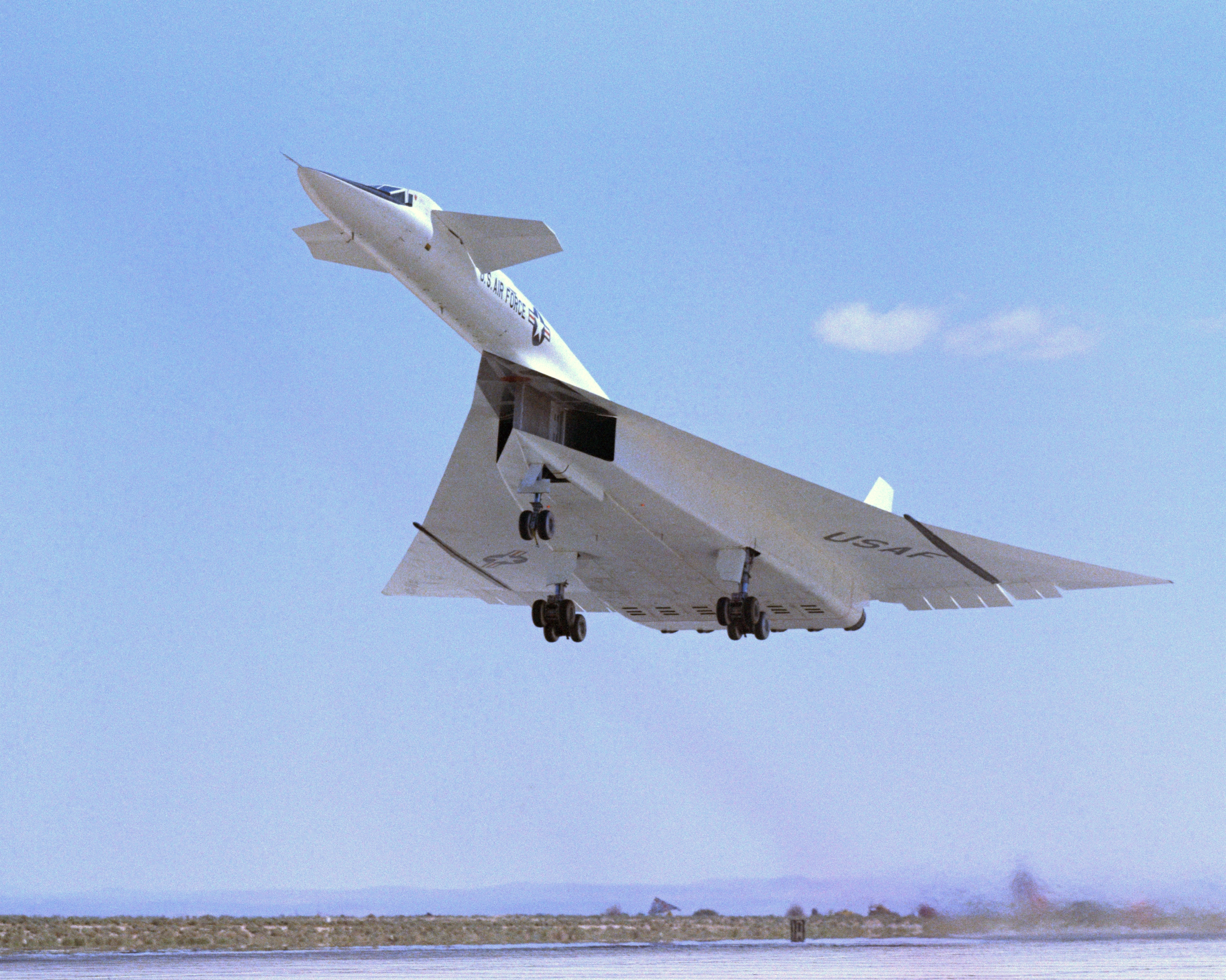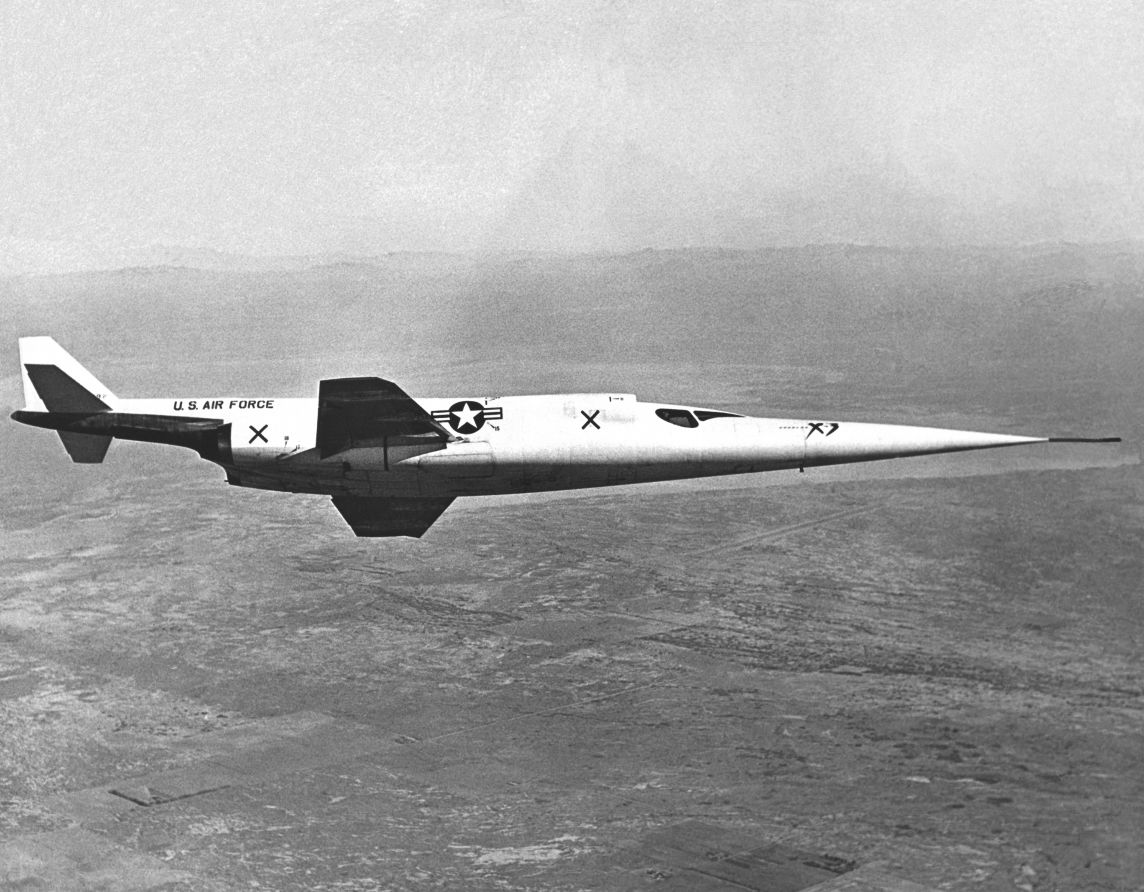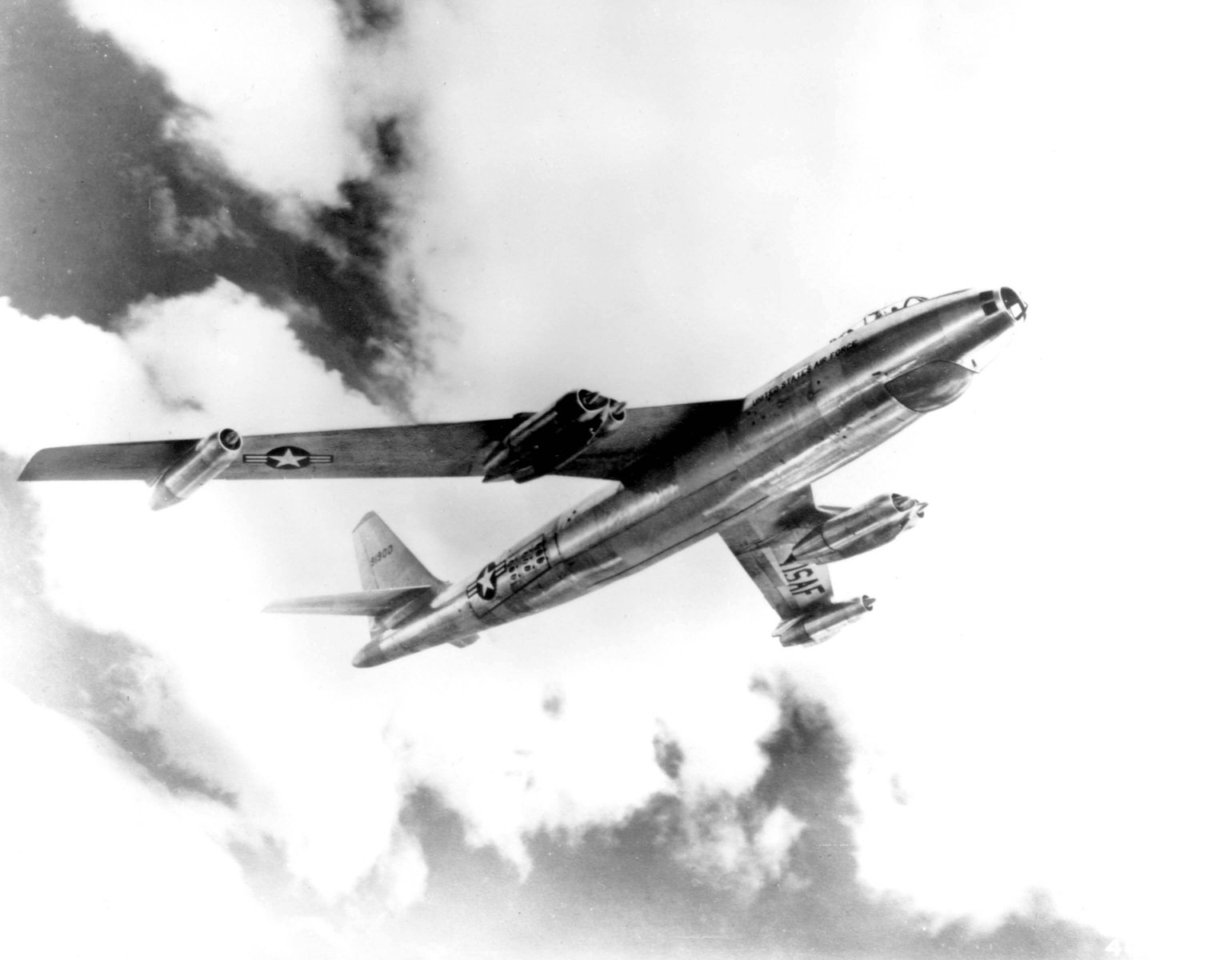Beginning in the late 1940s, the spaceships that streaked across the covers of science fiction magazines and books underwent a subtle but definitive change. Artists were no longer taking their design cues from the streamlined look of the 1930s; instead, the bullet-shaped rockets of the pulp era gradually gave way to vehicles with bubble canopies, stainless-steel plate fuselages, aggressive nose probes, and svelte teardrop fuel tanks perched on swept-back wingtips.
In those heady days, when science seemed to be catching up to science fiction one invention at a time (Jet and rocket engines! Nuclear-powered submarines! Space satellites! Television!), it’s hard to tell whether the artists were influencing the engineers, or the other way around. Perhaps, for just the briefest of moments in history, it was an ideal balance of both.
For imaginative kids growing up in the 1950s and 1960s, who wouldn’t want to join the U.S. Air Force and learn to fly the airplanes that looked like they had just flown out of the pages of their favorite stories? Here is a celebratory retrospective of some of the most inspiring — and inspired — designs from that era.
| #5: Convair XF-92 — Delta wings were a staple feature of science fiction spaceships of the 1950s-60s. The aggressive simplicity of a triangular wing is the distilled essence of the era’s high-speed aesthetic. And in the United States, the undisputed master of the delta was Convair. (Say that name out loud — Convair — doesn’t it even sound like it’s from the future?)
The spiffy XF-92 was the prototype for the delta winged fighters and bombers that came later, but of all its descendants, it’s the one that most resembles a spaceship. The long, tubular fuselage suggests a rocketship heritage, while the wings and tail seem almost comically exaggerated for effect. And yet, it really flew — and flew well, according to Chuck Yeager, who would know. |
| #4: North American XB-70 Valkyrie — North American’s intimidating delta-winged Valkyrie looked like it had flown straight from the Klingon homeworld. And apparently it behaved like it, too. Designed to fly at supersonic speeds to avoid enemy missiles, the Valkyrie never entered production, and ultimately did not herald the future of strategic bomber design. Nevertheless, this sleek behemoth looked like it could have ben one of the muscular spaceships that graced the covers of The Magazine of Fantasy & Science Fiction in the late 1950s And if the actual Valkyrie wasn’t freaky enough, check out what it might have looked like. Aim a squadron of those at the bad guys, and they’d surrender from being completely and utterly out-awesomed. |
| #3: Chance Vought XF5U-1 — The other dominant design aesthetic of the 1950s-60s in science fiction design was, of course, the flying saucer. During the “scares” of the early 1950s, newspapers were filled with stories of disc-shaped spaceships buzzing motorists on secluded roads or landing in abandoned quarries to spread the word of the galactic federation.
Serious science fiction magazines tended to avoid overly saucer-ish spaceship designs, probably out of a desire to avoid being lumped in with the likes of Fate in the minds of readers. But monster movies relied on the design heavily; most of the creatures that arrived on Earth to terrorize, colonize, or (occasionally) enlighten the human race came via circular spaceships. And occasionally, for example in Forbidden Planet, we returned the favor. The Chance Vought company was known for its radically interesting designs during the 1950s, only a few of which ended up in production before the company struck gold with its super-sleek F-8 Crusader, which John Glenn made famous in his 1957 record-breaking nonstop coast-to-coast supersonic flight. One of the more unorthodox designs — even by Vought’s standards — was the so-called “Flying Flapjack,” the XF5U-1 prototype fighter. Not a true flying saucer in the classic “alien spaceship” sense, it had the makings of a classic fictional design anyway; twin jet intakes, bulbous canopy, and ridiculously oversized propellors. In other words, if the Flying Flapjack hadn’t actually been invented, someone would have had to invent it. |
| #2: Douglas X-3 Stiletto — Few things say fast like the Douglas Stiletto. I mean, seriously. Just look at this thing. It’s like they stuck the wings and tail on just to give the pilot something to play with while the plane did whatever the heck it felt like doing up there in the thin air. This thing looks like it would bite your hand off if you tried to pat it on the nose.
Unfortunately, the great promise of the design was let down by its engines. The Westinghouse company, better known for refrigerators and elevators than jet engines, promised to deliver an engine that would fly the Stiletto to Mars and back before lunch — so the Douglas folks took them up on the dare and designed the plane to take two of them. But the engines sucked everything except air, and so the plane never flew as fast as it was designed to. Apparently, this didn’t make the Stiletto very happy, because it tried really hard to kill test pilot Joseph A. Walker, who smacked it right back and thereby managed to avoid the fate of fellow test pilot Steve Austin. |
| #1: Lockheed F-104 Starfighter — Here it is — the complete package. From the probe-tipped nose cone to the bubble canopy, to the stubby raked wings two-thirds of the way down the super-sleek rocket-shaped fuselage, to the chrome-like bare metal finish, to the wingtip fuel tanks, and — just because they could, apparently — to that rakish T-tail. And then there’s the name: Starfighter. It’s like they all knew that they had just built the coolest plane ever, so why not just admit it?
There’s a reason they called it “the missile with a man in it.” The Starfighter was originally designed to take on high-flying enemy bombers; the pilot’s job was basically to point the nose at the enemy and hit the “go” button. But over the years they discovered that the Starfighter was also a really rugged all-around fighter; ultimately nearly 2,600 (!!!) were built, serving in more air forces than just about any other American jet fighter and lasting an astounding 46 years before the last one was retired. Or, more accurately, successfully chained to the ground. From its looks to its name, the Starfighter is the hands-down champion science-fictional U.S. airplane from the golden age of the 1950s-60s. Because this is what the future once looked like. |
| Honorable Mention: Boeing B-47 Stratojet — I know what you’re thinking: “What’s so futuristic about a plane that looks just like every commercial airliner out there?” My answer is this: What you really should ask is, “Why does every airliner out there look like this plane?”
That’s what is truly science fictional about the Stratojet: quite simply, it established the Aristotelian perfect shape for multi-engined jet aircraft. Before the Stratojet, jet airplanes came in every shape imaginable. After the Stratojet, every big jet looked like — well, like the Stratojet. That’s pretty impressive for a design that was conceived right after World War II, isn’t it? In the 1950s and 1960s, science fiction artists showed us what things might look like in the future. The engineers at Boeing showed us what they actually would look like. Thanks, guys! |










What, no YB-49 Flying Wing?? Too obvious?
When the bad guys showed up and your 1950s sci-fi writer needed something to drop the atomic bomb on them, they turned to the flying wing.
Everything else was just a pale, flying wing imitation.
The YB-49 almost made the final cut. It’s one of my all-time favorite designs, but I reluctantly had to cut it because I just couldn’t find that many Golden Age spaceship designs that used a flying wing shape.
The Mars wing from Conquest of Space comes immediately to mind, but other than that, I couldn’t find anything from the 1950s-60s. (I’d love to be proved wrong, though!) And a friend on Facebook pointed out the giant bat-like flying wing from Things to Come, but that movie predates the entry’s Golden Age focus.
Now if we’re talking about “Cool Airplane Designs in Science Fiction Films,” that is of course a whole separate 37 Minutes entry — and the YB-49 would naturally get pride of place. Feel free to start tossing out some names for that entry in the comments!
I’m forced to not only disagree, but to do so vehemently (were my young daughter not in the room, it’s likely I would use even stronger language in this reply).
If you remain unconvinced, then ask yourself this simple question: WWCTRS?
(What Would Crow T Robot Say?)
I rest my case.
Well, shield your daughter’s eyes from the screen, pal, ’cause I’m throwin’ it down: It’s time to put your money where your fingers are!
Find me five science fiction cover art or movie stills from the 1950s-60s that have clearly flying-wing looking spaceships, and I’ll happily amend the post to include the YB-49 as the write-in candidate, and I’ll give you full credit for it.
And I’ll even let you use the Conquest of Space flying wing that I gave you, because — well, because that’s the kind of man I am.
As much as I’d love to chastise you again — further exposing your clear anti-flying wing bias to the entire sci-fi world — the wife’s out of the country retrieving our second daughter (we’re adopting my current daughter’s sister) and I’m looming up the truck with the kid and the ailing dog and heading south, where the happy family reunites this weekend.
A joyous occasion but a hectic one, so I’ll have to pass on any further embarrassment (yours, wing-hater, not mine).
Still, know that I’m watching you, alert for any further signs of false flying wing related punditry.
TC
A likely story, flying wing-nut. Nevertheless, congratulations are definitely in order! We wish you much happiness, and safe travels hither and home again.
Raise her to appreciate science fiction, and all will be well in the cosmos.
PDL
Pingback: The Five Most Science Fictional U.S. Cars of the 1950s-60s | Channel 37